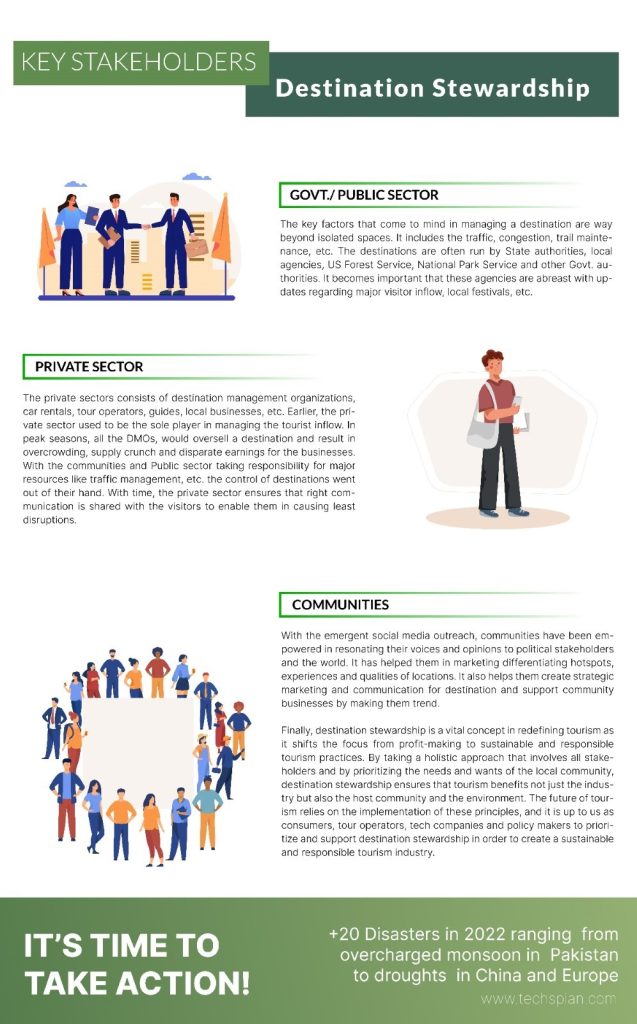BLOG
Redefining Tourism: The Power of Destination Stewardship in Building Sustainable Travel
Redefining Tourism: The Power of Destination Stewardship in Building Sustainable Travel
With 20+ climate disasters in the year 2022, ranging from overcharged monsoon in Pakistan to droughts in China and Europe, the world has been made aware of the life changing impact that the human life leaves on Earth. According to reports, in 2019, travel and tourism claimed up to 10.4% contribution to World GDP. While this figure reported a loss of more than 50% in the coming years, 2022 witnessed the travel industry surpass the 2019 levels with the recovery of 62 million jobs lost during the Covid era.
Post Covid, the world opened with entrapped travel needs, which went overboard the market expectations and caused major revenue recovery to some regions of tourism like Europe, US, Morocco and Mexico. While the financial recovery took place, the pressure on ecosystem was witnessed too.
Ever since, the world opened up and the recovery of tourism sector became priorities of the Governments, destination management organizations and the local communities that are most influenced by the maintenance of this ecosystem. The sudden stress on natural resources, demand & supply and governance called for a need of smarter and sustainable model of managing destinations.
A new term “Destination Stewardship” made rounds when it was re-introduced in the WTTC report. Destination Stewardship is an approach of destination management that balances the needs of travellers, the destination, the communities influenced by the tourism activities and falls in line aligns with governance models that are participatory in nature. While it may appear theoretical, it involves an intricate method of involving variety of crucial stakeholders which interact diligently with data, knowledge of local customs and mutual interests in mind. Public and private sectors equally participate in implementation of this approach.
Need for Destination Stewardship
With the recent onslaught of climate disasters in wiping out huge economical value, sustainability has taken a huge mind share in people’s mind. The role of sustainability is not limited to maintaining the environmental value of a destination but also embodies the concept of pooling in resources that provide much less benefits when each individual defines it from themselves. In general, the common pool resources could be habitats, infrastructure, historical monuments, water and energy resources, etc. In a concept of Destination Stewardship a system is brought in place that monitors the usage of resources in a manner it enables equitable sharing for all those who require them for daily use while maintaining that they exist for future generations too. The concept of sustainable includes much more than the resources of a destination. It also consists of the supportive structure that enables livelihood, residence and prosperity of local dwellers.
The history of tourism has witnessed several ups and downs, but what calls for the need of this approach today? Let’s glance through few factors that make a case for sustainable tourism:
Supply and Demand balance
The sudden burst of travellers in destinations and the supressed wait of local businesses to recover their lost revenue has become a cocktail of demand-supply imbalance. Suddenly, the most approachable destinations have witnessed a massive inflow that led to supply shocks. Organizations are having hard time in planning their inventory that leads to surplus expenditure and lack of planning. The pressure on the shared resources often goes unaccounted. There is a need to create an ecosystem that can predict the visitor inflow and add balance to socio economic state of destinations.
Evolving visitor interests
While the visitors come in with varied interests and convenience in mind, the desire to have an original touchpoint is expected by travellers. Things of personal importance like local gastronomy, health, sports, shopping need to be well integrated to fashion a destination that enables visitors to prioritise a place and aid local residents in acclimatizing to incoming surge of travellers.
Focus on value over volume
Post Covid era, there has been a differentiated sense of responsibility witnessed in local authorities that regard a sustainable growth of destination over unmanaged spurts of visitor inflow. The Government, local businesses and residents of destination have been showing their support to this viable model of growth.
Awareness of Governments
In the recent Independence Day, India’s PM Modi announced a mission to upgrade 15 destinations in India to a level that they are welcoming cross border tourism. Not only is it a classic push for Destination Stewardship, but also the extent to which this concept has been well recognized and acknowledged by local authorities. There is a place for various IT systems that enable this vision and empower local authorities to keep a track on the resources of their region.
Enabling Technologies
The evolving landscape for tourism creates a need of many more technologies. The businesses in silos have adopted technologies in the space of retail, travel, tourism and healthcare in a dominant manner and the paper trail has been significantly reduced. There is a scope of utilizing AI, Internet of Things, Virtual Reality, Augmented Reality, Biometrics and cloud computing in enhancing visitor experience. The component of technology becomes the Eureka element of “Destination Stewardship”. It acts like the missing piece of the puzzle that connects the complete system for the travellers to enjoy and stakeholders to improve visitor experience with actual data flows for real time incoming crowd monitoring and analysis of product diversification.
Social Inclusion
With the alternate work scenario, the world has been brought to speed with the hidden efficiencies of communities that were widely ignored earlier. The globe has welcomed diversity, people with disabilities and women in workforce with an impetus. Inclusion is also one of the major agenda under the UN Sustainable Development Goals, that encourage policy interventions, employment, support and actions that imbibe diversity. The Destination Stewardship model aids diverse communities to create prospects, support entrepreneurship and an equitable confluence of culture while enhancing the infrastructure of the destination.
Resilient Systems
The pandemic era was one of the worst times for the tourism industry. Destinations depending on a single source of revenue like tourism, community activities, sale of goods, etc. were amongst the most depraved. There is a pressing need for improved cohesion between public-private players that enable resilience to communities of destinations in shock scenarios like natural calamities, pandemics or terrorism. Destination Stewardship paves a way that solidifies these systems to better handle the shock scenarios.
The Need to be Sustainable
In 2001, in course of National Geographic’s “Sustainable Tourism” initiative, the concept of Centre for Sustainable Tourism emerged. National Geographic Traveller and Travel Industry Association of US started the concept of geo-tourism in 2002 which enhanced the geographical essence of any destination- the environment, economy, culture and heritage with well-being of the citizens.
Earlier, the tourism of any destination was limited to the efforts between the destination management organization, industry and to some extent, Government. However, with increased connectivity of geographies, globalization and social media, the negative effects of tourism began surfacing. As more and more effects disrupted resident lives, the more vocal the local communities became. It has become a need for communities and DMOs to act together and plan sustainable measures.
While the initial voices were heard in community meetings and political events, DMOs have begun smarter in utilizing technology to go towards a resident centric approach. Sentiment analysis is conducted at regular intervals to plan interventions. DMOs utilize informational systems in educating their travellers about the local know-how of the place, like peak traffic times, sensitive community guidelines, local festivals, etc. Not only does it enrich the experience of travellers, but it also prevents any disruption to local residents.

Finally, destination stewardship is redefining tourism as it shifts the focus from profit-making to sustainable and responsible tourism practices. By taking a holistic approach that involves all stakeholders and by prioritizing the needs and wants of the local community, destination stewardship ensures that tourism benefits not just the industry but also the host community and the environment. The future of tourism relies on the implementation of these principles, and it is up to us as consumers, tour operators, tech companies and policy makers to prioritize and support destination stewardship to create a sustainable and responsible tourism industry.

Related Topics
Want to build Super app for your business?



